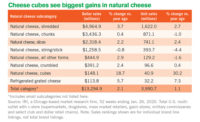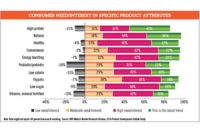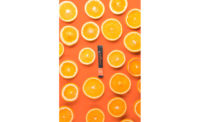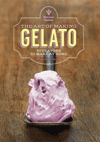
Natural High
by Julie Cook Ramirez
Riding the coattails of the low-carb craze, makers of
natural cheese enjoy increased consumption.
The phrase “diet
food” typically conjures up visions of oatmeal, rice cakes and green
leafy salads — hold the dressing, of course. And while many a pound
has been shed by sticking to such healthful (albeit bland) menus, dieting
no longer has to mean giving up flavor — or a sense of indulgence,
for that matter. In fact, today’s dieters may very well not get the
sense they are sacrificing anything at all in order to slim down.
After years of feeling they had to give up favorite
foods in order to lose weight, subscribers to the most recent widespread
diet crazes have found themselves not only allowed, but encouraged to
partake of such previously forbidden fare as steak, eggs and cheese. Under
the popular South Beach and Atkins plans, dieting became all about cutting
carbs and upping the protein. Despite concerns expressed by some in the
health care industry, who warned that such a diet could result in a
heightened risk of high blood pressure and cholesterol, consumers in droves
took to the reduced-carbohydrate craze — for a while anyway.
As with just about every other fad, diet or otherwise,
the low-carb craze had its moment in the sun. As it turns out, consumers
loved the effect such diets had on their waistlines, but found that they
just couldn’t eliminate such favorites as bread and potatoes from
their diet permanently. In due time, low-carb’s days were numbered,
as consumers began taking a more balanced approach to weight loss once
again.
That’s not to say the whole low-carb craze was
merely an exercise in futility. On the contrary, it opened consumers’
eyes to the effect that carbs have on their bodies and helped them adopt a
new approach to making smart food choices. In times past, for example, the
vast majority of consumers wouldn’t have even considered cheese when
seeking a healthy snack. Under the Atkins and South Beach plans, however,
cheese was branded a good choice due to its high-protein, low-carb
properties. Fortunately, such eating habits linger on, despite the fact
that the overall low-carb lifestyle has gone by the wayside for most
consumers.
“Even though people aren’t talking about
the low-carb diets as much anymore, you’ve still got a pretty
constant group of people that have woven that type of weight management
diet into their lifestyle on a regular basis,” says Steve Ostrander,
vice president of marketing for Lake Mills, Wis.-based Crystal Farms, a
subsidiary of Minnetonka, Minn.-based Michael Foods Inc.
| TOP 10 NATURAL CHEESE BRANDS* | ||||
| $ Sales (In Millions) | % Change vs. Year Ago | Unit Sales (In Millions) | % Change vs. Year Ago | |
| Total Category | $5,961.1 | 6.1% | 2,171.6 | 1.4% |
| Private Label | 2,136.9 | 4.3 | 880.1 | 1.3 |
| Kraft | 1,342.0 | 7.8 | 514.2 | 3.0 |
| Sargento | 414.1 | 11.1 | 151.5 | 5.9 |
| Tillamook | 201.1 | 8.0 | 44.5 | 3.3 |
| Crystal Farms | 138.1 | 9.8 | 61.9 | 7.1 |
| Precious | 105.3 | 6.7 | 27.3 | -10.6 |
| Polly O | 101.0 | 17.3 | 28.4 | 12.7 |
| Sorrento | 99.5 | -1.7 | 29.8 | -5.8 |
| Frigo | 96.5 | -6.5 | 29.8 | -10.2 |
| Borden | 79.7 | -3.3 | 38.2 | -10.5 |
| * Total sales in supermarkets, drug stores and mass merchandisers, excluding Wal-Mart, for the52-week period ending August 7, 2005. SOURCE: Information Resources Inc. | ||||
| TOP 10 NATURAL SHREDDED CHEESE BRANDS* | ||||
| $ Sales (In Millions) | % Change vs. Year Ago | Unit Sales (In Millions) | % Change vs. Year Ago | |
| Total Category | $2,019.2 | 5.7% | 809.1 | 2.9% |
| Private Label | 868.5 | 6.4 | 365.1 | 5.7 |
| Kraft | 567.0 | 8.7 | 222.4 | 2.8 |
| Sargento | 222.5 | -0.3 | 85.4 | -2.7 |
| Crystal Farms | 80.6 | 8.9 | 30.8 | 6.0 |
| Borden | 57.0 | -6.5 | 26.7 | -14.2 |
| Kraft Free | 31.1 | 7.0 | 11.2 | 3.5 |
| Kraft Classic Melts | 29.0 | -12.8 | 12.0 | -15.5 |
| DiGiorno | 22.9 | -8.6 | 6.5 | -13.1 |
| Stella | 13.1 | 8.5 | 4.0 | 2.9 |
| Sargento Bistro | 11.6 | 340,659.2 | 5.0 | 425,605.0 |
| * Total sales in supermarkets, drug stores and mass merchandisers, excluding Wal-Mart, for the52-week period ending August 7, 2005. SOURCE: Information Resources Inc. | ||||
With more consumers picking up cheese due to its
positive nutritional attributes, natural cheese, in particular, has
experienced growth. According to Jay Allison, national sales manager for
Tillamook County Creamery Association, Tillamook, Ore., it’s all
about trust. People generally know that natural cheese is made from
natural, wholesome ingredients. They’re not so sure, however, exactly
what goes into making “pasteurized processed cheese.” Thus,
they’ve embraced natural cheese in larger numbers than ever before,
particularly when it comes to areas that were previously dominated by
processed, such as slices.
“Consumers are gravitating much more toward
sliced natural cheese, as opposed to processed,” says Barbara Gannon,
vice president of corporate and marketing communications, Sargento Foods,
Plymouth, Wis. “We think that’s a trend that’s going to
continue.”
The growing popularity of natural cheese is evident in
the latest data from Chicago-based Information Resources Inc. (IRI), which
shows natural cheese sales rising 6.1 percent in dollars and 1.4 percent in
units during the 52-week period ending August 7, 2005, in supermarkets,
drug stores and mass merchandisers, excluding Wal-Mart. Sales of natural
shredded cheese rose 5.7 percent and 2.9 percent, respectively.
“People are looking for a more simplistic way of
getting their nourishment,” says David Leonardi, director of cheese
education and events, Wisconsin Milk Marketing Board, Madison, Wis.
“When it comes to natural cheese, they just feel that it’s a
cleaner product, a better product. It’s more real.”
Answering the Call
Recognizing the growing interest in sliced natural
cheeses, Kansas City-based Dairy Farmers of America (DFA) recently added a
Colby/Monterey Jack variety to its line of Borden Natural Slices, which
previously included only Swiss and Cheddar varieties. Building on the
popularity of its Borden String Cheese, introduced three years ago, DFA
recently rolled out Borden Kid Builder Natural Mozzarella String Cheese,
fortified with six essential vitamins and minerals — vitamins C, A,
E, B6,
calcium and zinc.
The company has also introduced Borden Snack Bars, a
line of 2-ounce cheese bars designed to compete with candy bars. Boasting
easy-opening, bilingual packaging, Borden Snack Bars are available in four
flavors — Sharp Cheddar, Mild Cheddar, Colby/Monterey Jack and Pepper
Jack.
According to Mark Korsmeyer, president of DFA’s
American Dairy Brands and Dairy Products Groups, it’s all about
building on the momentum currently being enjoyed by natural cheese.
“Our mindset was to parlay upon [the success of] string cheese, so we
asked ourselves what other portable snack-size items we could develop
within the natural cheese category,” he explains. “The
resulting product takes the growth of natural cheese to a higher awareness
level and hopefully, to a higher consumption base.”
If U.S. cheese processors ever hope to approach the
astronomical 40 to 50 pounds per person consumption rates seen in Europe,
Leonardi says they must first tackle two main stumbling blocks. First, they
need to find ways of making cheese more of a stand-alone food, rather than
merely one that is used on and in other foods.
“In the United States, cheese is consumed more as
an ingredient than anything else,” he says. “We have a passion
to put cheese into or onto something, as opposed to Europe, where cheese
stands alone more often than not. We’ve got a long way we can grow in
that respect.”
To Your Health
In addition, Leonardi says, cheesemakers need to
address the misconception that lactose intolerant people cannot eat cheese.
This can best be accomplished by educating consumers that the lactose
content in cheese is practically non-existent, because it “goes down
the drain in whey during the cheese-making process,” he notes.
Therefore, those individuals with lactose intolerance need not avoid cheese
out of fear of stomach upset.
The very popularity of cheese itself presents a
challenge in further growing consumption, according to Ostrander, who
claims that Americans purchase cheese at a rate of 30 to 40 times per year.
Add that to the fact that cheese is purchased by 98 percent of all
households and per capita consumption is rapidly approaching 31 pounds per
person, and the question emerges as to where future opportunities can be
found.
“Anytime you have close to 100 percent household
penetration and you have a high purchase rate like you do with cheese,
everyone is waiting to see if there’s going to be some new technology
that makes it better, more convenient, more flavorful, more healthy,”
he says. “Unless you get a real technological breakthrough or you
have a situation like we had last year with the low-carb craze, you
don’t see big jumps in mature categories like this.”
If Carl Brothersen has his way, some of those future
jumps in consumption may come in the form of vitamin-enriched natural
cheese. As associate director of the Western Dairy Center at Utah State
University in Logan, Utah, Brothersen has developed a method for enhancing
the nutritional profile of natural cheese by injecting vitamins.
Utilizing a proprietary high-pressure injection
technology, Brothersen injected liquid vitamin D, B6 and folic acid into
mozzarella and cheddar cheese. Then, under the sponsorship of Rosemont,
Ill.-based Dairy Management Inc. (DMI), he set out to determine whether the
addition of the vitamins has any effect on the flavor or the ripening
process of the cheeses. Fortunately, they do not. Ultimately, Brothersen
hopes this process will result in commercially-available vitamin-enriched
cheeses, specially fortified for people with particular health concerns.
“Someday, you will be able to buy
vitamin-enriched cheeses, just like now you can buy other vitamin-enriched
foods, such as breakfast cereals and fluid milk,” says Brothersen.
“I wouldn’t expect it to become standard that all cheeses would
have this, but it could become a niche market for people with certain
nutritional needs.”
Julie Cook Ramirez is a freelance journalist based in
the Chicago area.
$OMN_arttitle="Natural High";?>


